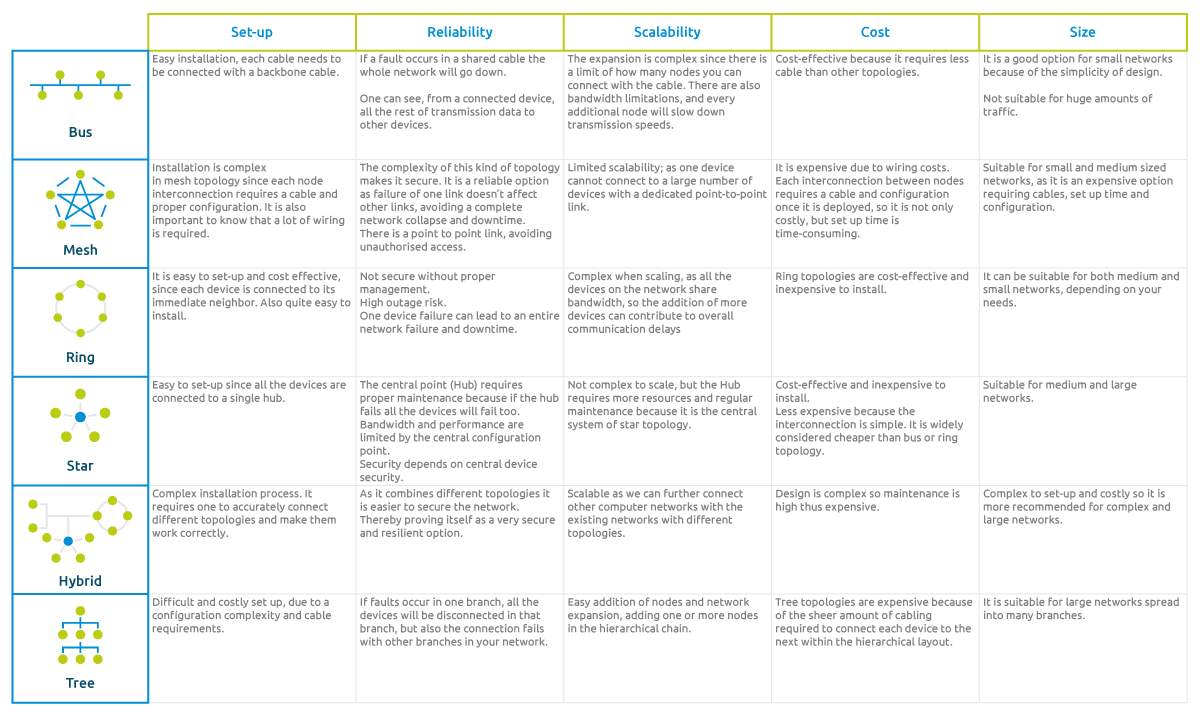13 Dec 2021
Network Topology offers you a comprehensive layout of how nodes and connections are arranged in your network.
The way your Network Topology is defined affects your network performance, fault detection, scalability, and operational effectiveness. Therefore, it is crucial that you understand your goals and requirements in order to create and manage your network topology correctly.
What exactly is network topology?
Network topology can be defined as the map of the interconnections between numerous nodes and devices arranged physically and/or logically amongst themselves.
We are all familiar with the Google Maps tool, however, imagine that your network is represented on a map and its roads are the connections between the different elements of your network. Hence, there are various ways of organizing and maintaining a city; facilitating the connection between the streets, speeding up the traffic on more saturated roads, crossroads, signs to be followed, etc.
A network management system allows you to organise your network in a Topology Map. It will, however, depend on the complexity of your network, the number of devices in use, the type of services it handles, scalability, among many other aspects.
Network topology involves two kinds of topologies: physical and logical.
The physical network topology represents the physical layout. Showing you physical connections and interconnections between the nodes and the network.
The logical network topology is a bit more business oriented and strategic, so it enables you to know how the network is organized and how data flows through it.
Network topology types:
- Bus: different devices are connected to a single communication channel. Or in other words, all devices are connected to a common link.
- Mesh: each device is interconnected to all the other devices in the network. In this way it is possible to transfer data from one node to another via different path alternatives.
- Ring: when we talk about ring topology, we’re talking about circular data connection in a closed loop. Each device is connected to two other devices, creating a circular path where data is transferred.
- Star: in this kind of network topology, nodes are connected to the central connection point. All the information sent from the network devices passes through the central point to be properly delivered.
- Hybrid: means several different interconnected topologies. Often, a combination of two or more basic network topologies.
- Tree: is a hybrid topology, often used to interconnect nodes, in a hierarchical way utilising bus networks.
Network topologies comparison
In order to better visualize the process and make it easier for you to understand, we created the following table with network topologies highlighting their general differences:

What to consider when defining your network topology?
To achieve a resilient, safe, trouble-free and effortless topology, your choice will be conditioned by the number of devices on your network, performance requirements, security and scalability needs.
The type of the topology you choose will depend on your needs, objectives, budget and size of your network.
A perfect solution does not exist, or even a standard model compatible with all businesses – each topology has its pros and cons. Therefore, the choice will always be conditioned by two main factors: your organisation’s requirements and the amount of network elements you need.
We recommend you also take into consideration these other key aspects:
- Budget.
- Scalability.
- Type of cable and the length.
- Hardware resources.
- Implementation time and difficulty level.
- Configuration and maintenance.
Why is network topology important for your business?
Topology plays an essential aspect for your network functioning and performance. Choosing the correct network topology option for your business can lead to numerous benefits such as:
- Improving the performance of your network.
- Simplifying fault detection processes, thus enabling you to locate any error easily.
- Bettering resources and inventory management.
- Reducing maintenance and configuration costs.
- Improving the security of your network.
- Considerable time-savings.
- Operational costs reduction.
How can our NMS help you manage your network?
Our network management system offers you advanced Topology Maps with multiple options available:
- Customised maps according to your needs. You will be able to create your personalised maps and organise the map into several independent areas, if required.
- Physical and logical representations are available in a Tree Viewer.
- Transmission layer and Access layer.
- Hierarchical organisation of layers, according to your needs.
- Circuits visualisation including elements such as customers, services, and internal links.
- Sites, network elements and links status are represented.
- Drill deeper into your network topology information. By clicking on different elements you will be able to visualise devices, circuits, links, etc.
- Improve your fault management by allowing you to visualise affected services highlighted on a Map.
- Additional Family Map Viewer where you can navigate, open families and the devices related to each family group.
Our network management system goes one step further and brings you more than just a simple topological view. SGRwin enables you to manage your Topology Maps the way you want it to; visualise network elements, links, sites, circuits, services affected, etc. Moreover, it helps you improve your fault management, as you will be able to visualise the status of your network elements and get a more comprehensive view of their information.
